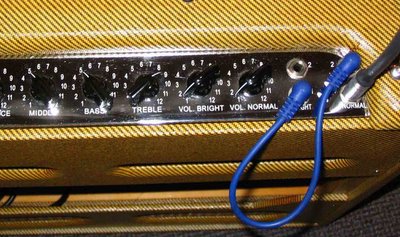Amplified harp tone tip – channel jumping.
By the Tone Chaperone
I blow harp through a Victoria Bassman clone that I bought from Stoop Down about a year ago. A damn fine amp, it’s a clone of the classic 1959 Fender Bassman amp that was a flop as a bass amp but became very popular with guitarists. The original Fenders are collectors items now – originally costing about $340, these amps in very good condition are selling for over $4,000 these days.
The Bassman is also a great harp amp. In fact, it’s kind of unusual to see pro blues harp players not using a Fender Bassman or a reasonable facsimile. With 45 watts of power and four ten-inch speakers, this amp can deliver the big, fat harp tone that has been heard on gazillions of blues recordings.
Like most gearheads, I’m always fooling around with my amp, mics, cords, etc. in the never-ending quest to improve my tone. I recently discovered that, by jumping the two channels in my Victoria, I can sort of supercharge my sound. I guess this is a trick that guitar players have known about for ages. Here’s how it’s done:
1. Plug the mic cord into the No. 1 jack of the Normal channel.
2. Plug one end of a patch cord into the No. 2 jack of the Normal channel.
3. Plug the other end of the patch cord into the No. 1 jack of the Bright channel.
Now the Volume controls on both channels are active and affect the volume and tone of the amp. This seems to add more punch and presence to an already great sounding amp. The channels can also be jumped the other way - that is, from the Bright to the Normal channel. I really dig this sound and patch the channels together on my amp all the time now.
Normal to Bright channel jump.
However, channel jumping might not work too well for a rookie harp player having the usual problems with feedback. Getting the two volume controls balanced will be a lot easier for an experienced player with good mic technique.
Next up: I’m probably going to replace the Chinese and Russian tubes in the Victoria with New Old Stock (NOS) tubes. I’ll keep you posted.
Thanks and a tip of the hat to Nick Carnavalli for hipping me to the channel jumping technique. For an excellent reference on Fender amplifiers, check out “Fender Amps – The First Fifty Years” by John Teagle and John Sprung. Good stuff!

2 comments:
I can attest to the benefits of this "trick". And I know several other cats who jump channels, too. While both channels do interact at some point since they share the same preamp tube, jumping can achieve desireable results much sooner on the volume knobs. Which, by the way, "go to 12. It's 2 louder than 10."
While I'm at it, let me say this... everytime I've heard Mike perform, he's had a HUGE sound. I first heard him play at a Harmonica Blowoff in Portland. When he took the stage and blew the first few notes, his superior tone was evident to all. And he was in the company of some pretty big "dogs", too. Part of it's due to jumping channels, part of it's due to his gorgeous Vicky... but mostly it's due to his great tone.
Check this out... look carefully at how his tone controls are set up. Go ahead... I'll wait...
No, that photo is NOT doctored up. He's actually using more treble than bass! And that's usually as high as he's got the Vicky turned up! A word of warning to rookies... DON'T TRY THIS AT HOME!!! I know there are some who will say it's "all wrong", or that it's "backwards."
But wait til you hear the cat. Then, and only then, will you know... this boy's the real deal.
Ray - Thanks for the kind words!
Ray is a terrific harp player that helped us out on the recent Superharp Showcase in Pioneer Square. I will be publishing a writeup of that show in the next couple of days.
Post a Comment